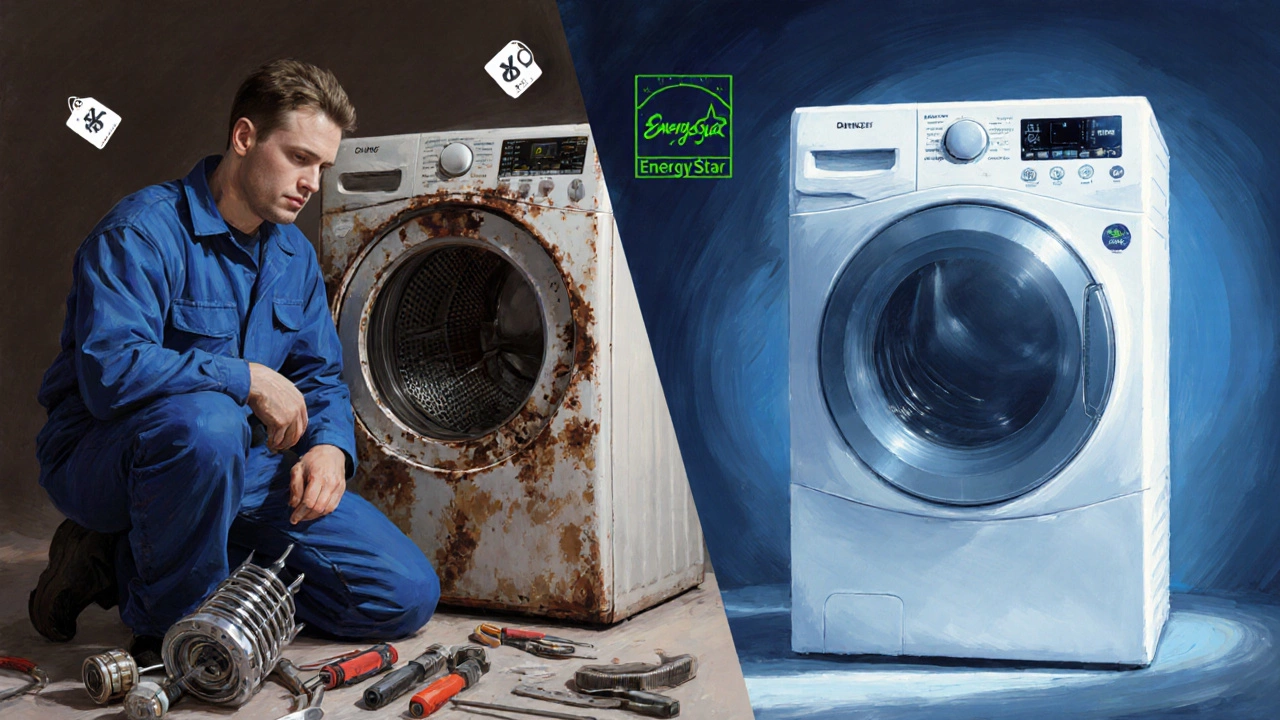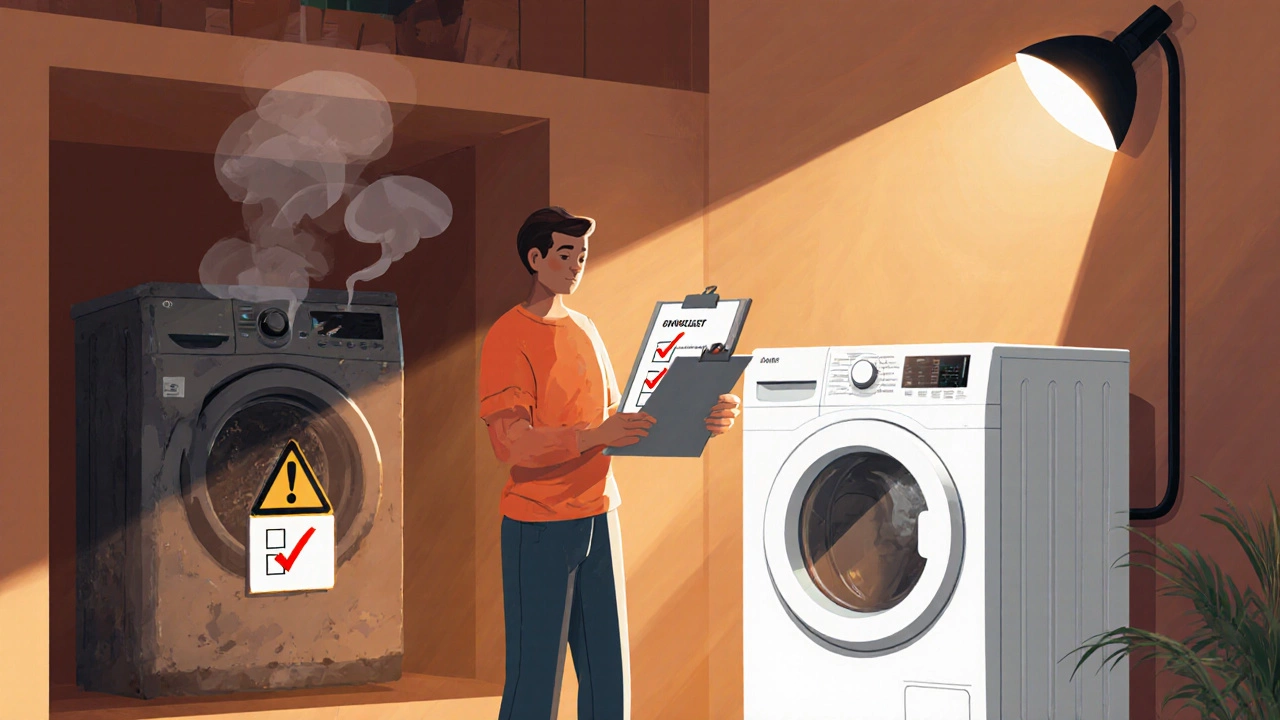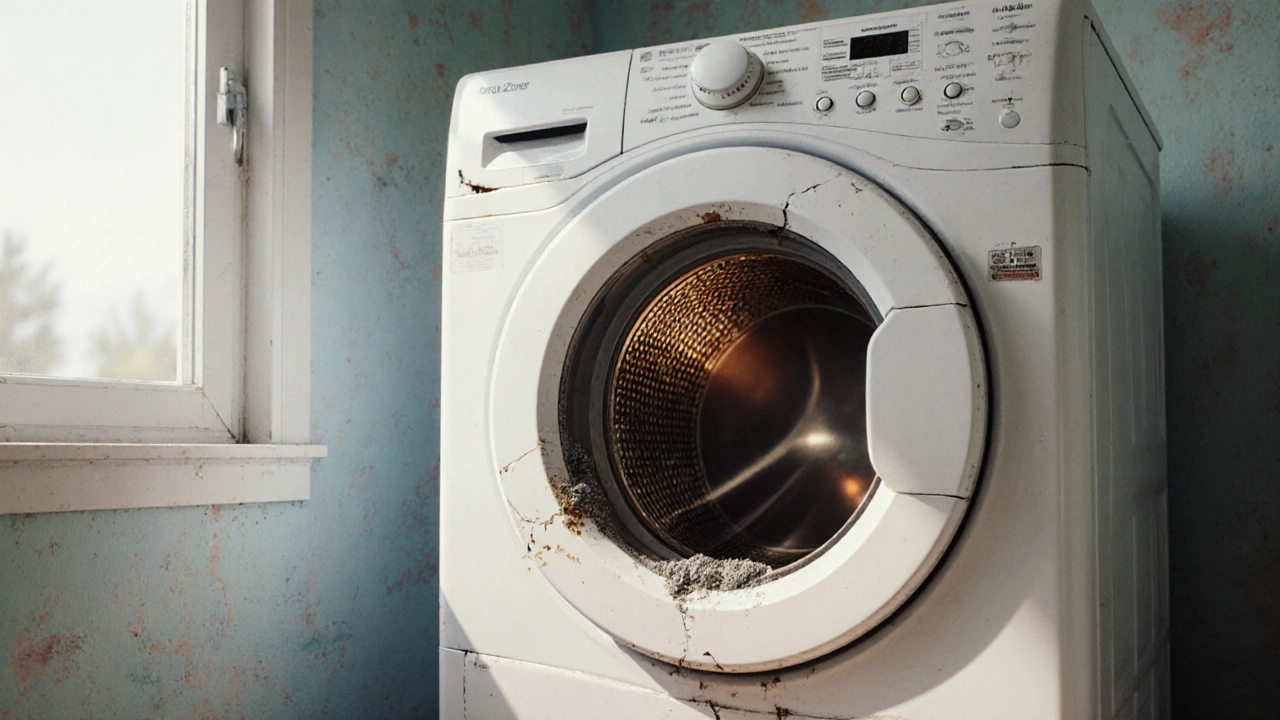Dryer Repair Cost Calculator
Repair vs. Replace Calculator
Determine if repairing your dryer is worth it based on age, cost, and safety factors.
Enter your dryer details to see if repair or replacement is recommended.
When a Tumble dryer fails to dry clothes efficiently, emits strange noises, or shows error codes, the first instinct is often to call a repair service. But not every fault is worth fixing. Knowing when the repair bill outweighs the benefits can save you money, keep your home safe, and even improve energy usage.
What Makes a Repair Worthless?
Three factors usually decide the break‑even point: the dryer’s age, the cost of the specific part, and the overall energy efficiency of the model.
- Age: Most manufacturers warranty a dryer for 2-3 years. After about 10‑12 years, the likelihood of multiple component failures spikes.
- Part price: Replacing a heating element or a motor can cost $150‑$300 in parts alone.
- Energy use: Older drums often run hotter and use more electricity, raising your utility bills.
If any of these numbers start to eclipse the price of a new unit, it’s time to think about replacement.
Common Failures and Their Repair Costs
Below is a quick look at the most frequent problems and typical price ranges for parts and labor.
| Problem | Typical Part Cost | Labor (avg.) | Total Estimate |
|---|---|---|---|
| Linter filter clog | $0‑$20 | $30‑$50 | $30‑$70 |
| Thermostat failure | $25‑$70 | $80‑$120 | $105‑$190 |
| Heating element burn‑out | $120‑$250 | $80‑$120 | $200‑$370 |
| Drum bearing wear | $80‑$150 | $100‑$150 | $180‑$300 |
| Control board failure | $150‑$300 | $100‑$150 | $250‑$450 |
Simple fixes like a clogged lint filter are cheap, but once you start hitting the $200‑$400 range, compare that amount to the cost of a new, energy‑star rated dryer (typically $600‑$900).
Safety Hazards That Tip the Scale Toward Replacement
Some problems aren’t just expensive; they’re dangerous. A faulty heating element can overheat and ignite lint. A broken venting system may cause carbon monoxide buildup in homes with gas‑powered models.
If you smell burning, notice hot spots on the dryer’s exterior, or see smoke, stop using the appliance immediately. Even a professional repair might not guarantee long‑term safety on an aging unit.

Energy Efficiency and Environmental Impact
Modern dryers boast energy‑star ratings that reduce electricity consumption by up to 30 % compared with models from the early 2000s. Switching to a newer unit can offset the upfront cost through lower monthly bills.
On top of that, older dryers tend to release more micro‑fibers into the laundry water, contributing to environmental pollution. Newer machines often include moisture sensors that stop the cycle as soon as clothes are dry, further cutting waste.
Decision Checklist: Repair or Replace?
- Is the dryer older than 10 years?
- Is the estimated repair cost more than 50 % of a new dryer’s price?
- Does the problem involve fire‑risk components (heating element, venting, thermostat)?
- Is the unit still under warranty?
- Do you notice a sharp increase in energy bills?
If you answer “yes” to three or more of these, replacement is the smarter move.
Repair vs. Replace: Side‑by‑Side Comparison
| Factor | Repair | Replace |
|---|---|---|
| Initial cost | $150‑$400 | $600‑$900 |
| Projected lifespan after fix | 2‑5 years | 10‑12 years |
| Energy consumption | Older model rates | Energy‑star efficiency |
| Safety risk | Depends on repaired part | Modern safety standards |
| Environmental impact | Continues older emissions | Reduced micro‑fibers & electricity |

When to Call a Professional
A qualified professional technician should handle any electrical or gas‑related repairs. Even if you’re comfortable with DIY, reversing a gas line or recalibrating a thermostat without proper training can void warranties and breach safety codes.
Look for technicians who are certified by the manufacturer, carry liability insurance, and offer a written estimate before starting work.
DIY Tips for Minor Issues
- Clean the lint filter after every load to maintain airflow.
- Inspect the venting system monthly; clear any buildup with a brush.
- Reset error codes by unplugging the dryer for 2 minutes; many electronic glitches clear themselves.
- Replace a worn drum belt yourself if you’re handy; kits cost $15‑$30 and come with clear instructions.
These quick fixes can extend the life of a dryer that’s otherwise in good shape.
Next Steps After You Decide
If you choose repair, request a written estimate that breaks down part and labor costs. Compare that number to current market prices for new dryers that fit your space and load capacity.
If you opt for replacement, look for models with an energy efficiency rating of at least 80 %, a robust warranty (preferably 2‑year parts & labor), and a built‑in moisture sensor.
Either way, keeping receipts and maintenance records will help you track costs and warranty claims down the line.
When is a dryer repair no longer cost‑effective?
If the dryer is over 10 years old, the repair estimate exceeds half the price of a new model, or the fault involves fire‑risk components, replacement usually makes more sense.
Can I fix a dryer myself without voiding the warranty?
Simple tasks like cleaning the lint filter, clearing the vent, or replacing a drum belt are generally safe. Anything electrical or gas‑related should be left to a certified technician to avoid voiding the warranty.
How much should I expect to pay for a professional dryer repair?
Most repairs fall between $100 and $300 for labor, plus parts ranging from $20 for a filter to $250 for a heating element. Always ask for an itemized quote before work begins.
What are the energy savings of a new Energy‑Star dryer?
Energy‑Star dryers consume up to 30 % less electricity than models built before 2010, which can translate to $40‑$80 of annual savings on average.
Is it safe to use a dryer with a faulty thermostat?
No. A malfunctioning thermostat can cause the dryer to overheat, creating a fire hazard. Replace it promptly or consider a new unit if the dryer is old.


